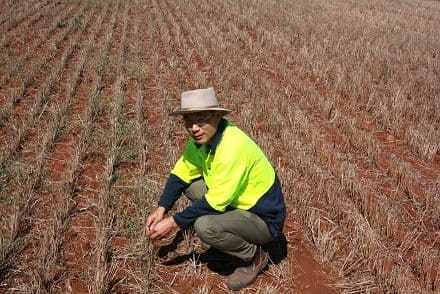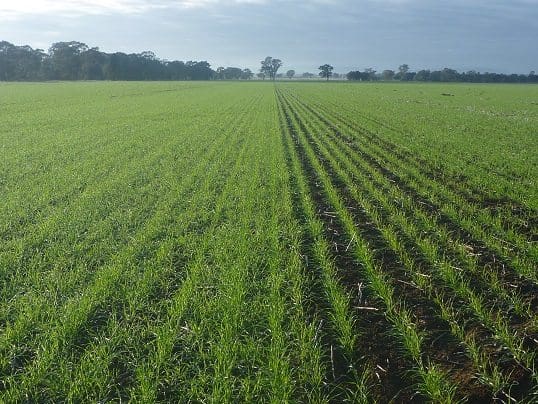Ask a WeedSmart Expert
The inter-row space provides an ideal environment for weeds to grow, particularly if pre-emergent herbicides are not applied or are less effective than expected.

NSW DPI’s Dr Hanwen Wu is investigating new ways to increase crop competition, particularly in the crop inter-row space.
NSW Department of Primary Industries principal research scientist, Dr Hanwen Wu says filling the inter-row space with a productive species might be another way to suppress weed growth and reduce seed production of herbicide resistant weeds.
“There is very strong evidence that narrower rows are an excellent way to increase crop competitiveness but there are some practical limitations,” he said.
“We have looked at a combination approach, of planting most of the seed in rows and the rest broadcast to ‘fill in the gaps’. We have called this the ‘compound sowing technique’.”
In 2016 Dr Wu set up two field trials at different locations near Wagga Wagga, NSW to assess the effect of this system on weeds and crop yield in both narrow (22.5cm) and wider (45cm) row spacings, with and without IBS trifluralin.
Three broadcast species were evaluated – wheat, gland clover and French serradella. The two sites were assessed to have an initial annual ryegrass density of 48 and 25 plants/square metre.

Compound sowing technique (conventional + broadcast sowing) dramatically increases crop competition in the inter-row compared to conventional sowing. Of the three broadcast species tested, wheat provided the strongest suppression on weed biomass.
“We sprayed out the broadcast legumes in early September to prevent them competing with the crop for moisture,” Dr Wu said.
“Further trials are needed to test a range of parameters such as suitable legume species, optimal seeding rates, proportion of seed broadcast, row spacing for the conventional seeding and different pre-emergent herbicide options.”
Although the 2017 season did not allow Dr Wu to replicate this trial he is keen to do more trials in 2018.
“We think this technique has merit and our initial trial suggested that weed suppression can be achieved without any yield penalty,” he said.
“There even seems to be situations where a yield increase can be achieved in response to reduced weed pressure.”
Crop competition is rightfully attracting more attention from farmers and researchers in the war on herbicide resistant weeds.
It is a numbers game and crop competition can play an important role in vastly reducing weed seed set.
Which was the most competitive broadcast species?
Short answer: Wheat.
Longer answer: At the weediest site the broadcast wheat treatment, without IBS trifluralin reduced annual ryegrass biomass by 71–77 per cent at both the narrow and wider row spacings. In the presence of less weeds the broadcast wheat still reduced weed biomass by 50pc in the narrow rows and 27pc in the wider row configuration.
IBS trifluralin further increased weed suppression at both sites and both row spacings. At the weedier site, annual ryegrass biomass was suppressed by 88–90pc. Where there were less weeds present the addition of IBS trifluralin increased biomass suppression from 27pc to 70pc at the wider row spacing.
What was the effect on yield?
Short answer: The wheat yield increased by 15–22pc at the weediest site when wheat was used as the broadcast species.
Longer answer: In the favourable season of 2016, only broadcast wheat generated a yield increase, and only in the presence of higher weed pressure. None of the broadcast treatments caused a yield reduction at either site. Further trials are required to evaluate the impact of site and seasonal climatic conditions on the weed control and crop yield associated with the compound sowing technique.
The broadcast legumes may provide additional soil fertility and moisture retention benefits while maintaining crop yields. More work is needed to identify more competitive legume species to have a greater impact on weed biomass and to identify the optimal timing to kill broadcast legumes to maximise weed suppression and minimise yield loss.
Have any farmers tried this idea?
Short answer: Yes.
Longer answer: Leigh Bryan at Swan Hill has tested this idea on his farm – he calls it zero-row spacing. Also in 2016, a strip-trial in barley resulted in the zero row spacing strip yielding 4.994 tonnes/hectare compared to 4.889t/ha in the conventionally sown crop at 37.5cm spacing. This was achieved with no pre-emergent or in-crop herbicide applied.
Leigh has noticed that the random placement of stubble is easier to sow through the next year and it still provides trellising for pulse crops and shades the soil to conserve moisture and reduce soil surface temperatures.
Source: Weedsmart
……………………………….
How to ask a WeedSmart question
Ask your questions about crop competition on the WeedSmart Innovations Facebook page WeedSmartAU, Twitter @WeedSmartAU or the WeedSmart website https://weedsmart.org.au/category/ask-an-expert/
‘WeedSmart’ is an industry-led initiative that aims to enhance on-farm practices and promote the long term, sustainable use of herbicides in Australian agriculture.

HAVE YOUR SAY